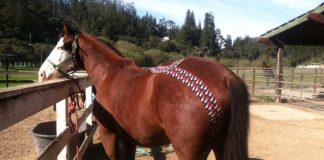 With summer just around the corner, now is the time to vaccinate horses against Potomac horse fever (PHF).
With summer just around the corner, now is the time to vaccinate horses against Potomac horse fever (PHF).
PHF is a potentially deadly disease that can cause mild depression, anorexia, diarrhea and abortion in pregnant mares. Some horses also may develop severe toxemia, and up to 40 percent of horses with PHF will develop laminitis.
PHF is caused by aquatic insects, such as caddisflies and mayflies that are infected with the agent of disease, Neorickettsia risticii, and is traditionally seen in the summer and early fall during the insects’ peak hatching times. Horses can ingest infected aquatic insects while grazing near waterways.
Caddisflies, mayflies and other carriers also swarm around barn lights, causing infection even while horses are stabled. “Insects like to swarm around lights,” says Dr. Frank Hurtig, DVM, MBA, director, Veterinary Services, Merial. “That’s why it’s so important to keep hay and water away from lights that stay on all night. Once those infected insects die, they may fall directly into the horse’s food and water source.”
Traditionally seen in areas surrounding freshwater streams and other bodies of water, PHF has been found in nontraditional areas, including northern Wyoming and Minnesota. In fact, PHF has been known to occur in 43 states, three Canadian provinces, and parts of South America, The Netherlands, France and India.
“PHF boundaries are very blurry,” Dr. Hurtig says. “Horse owners should consider their proximity to bodies of water, their travel plans for the summer, and most importantly, consult their veterinarian about vaccinating for PHF.”
Dr. Hurtig advises horse owners to talk with their veterinarians about a vaccine that is proven safe and effective. In one study, the PHF vaccine POTOMAVAC protected 86 percent of horses from clinical disease. It also is proven safe for horses as young as 3 months and is available as a combination of Equine POTOMAVAC + IMRAB® to help protect against both PHF and rabies.







Good info – thanks!
good to know.